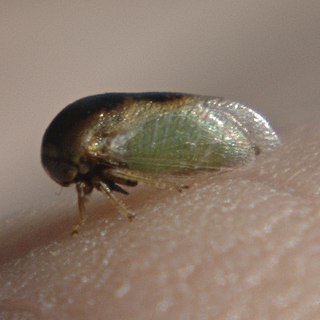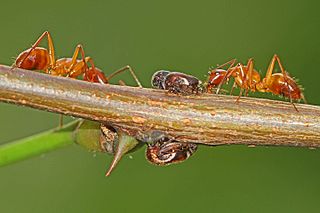
Treehoppers and thorn bugs are members of the family Membracidae, a group of insects related to the cicadas and the leafhoppers. About 3,200 species of treehoppers in over 400 genera are known. They are found on all continents except Antarctica; only five species are known from Europe. Individual treehoppers usually live for only a few months.

The buffalo treehopper is a species of treehopper belonging to the subfamily Smiliinae. It is sometimes classified as Ceresa bisonia.

Enchenopa binotata is a complex of multiple species found mostly in Eastern North America, but have also been reported in Central America. They are commonly referred to as treehoppers and are sap-feeding insects. The species in the complex look similar to each other in morphology, but are identified as different species by the host plant they occupy.

Entylia is a genus of treehoppers in the family Membracidae. There are at least three described species in Entylia.

Polyglyptini is a tribe of treehoppers in the family Membracidae. There are at least four genera and about nine described species in Polyglyptini.

Entylia carinata, commonly known as the keeled treehopper, is a species of treehopper in the family Membracidae. They can be found in Brazil, Panama, Mexico, the United States, and Canada. Keeled treehoppers are often attended by ants which feed on the honeydew they excrete. In return, the ants offer protection from predators. Keeled treehoppers typically feed on plants in the aster family and they are not known to transmit plant diseases and are not considered significant plant pests.

Microcentrus is a genus of treehoppers in the family Membracidae. There are about 10 described species in Microcentrus.

Micrutalis is a genus of treehoppers in the family Membracidae. There are at least 30 described species in Micrutalis.

Smiliini is a tribe of treehoppers in the family Membracidae. There are about 6 genera and at least 40 described species in Smiliini.

Ophiderma salamandra is a species of treehopper in the family Membracidae.

Polyglypta is a genus of treehoppers in the family Membracidae. There are at least three described species in Polyglypta.

Telamona is a genus of treehoppers in the family Membracidae. There are at least 38 described species in Telamona.

Telamonini is a tribe of treehoppers in the family Membracidae. There are about 9 genera and at least 50 described species in Telamonini.

Thelia bimaculata, the locust treehopper, is a species of treehopper in the family Membracidae.

Thelia is a genus of treehoppers in the family Membracidae. There are at least two described species in Thelia.

Thelia uhleri is a species of treehopper in the family Membracidae.

Tylopelta is a genus of treehoppers in the family Membracidae. There are at least four described species in Tylopelta.

Vanduzea arquata, the black locust treehopper, is a species of treehopper in the family Membracidae. It is found in North America. Females lay their eggs in the buds of black locust trees. These membracids are attended to by ants, such as Formica subsericea.

Vanduzea is a genus of treehoppers in the family Membracidae. There are about 12 described species in Vanduzea. The genus was named after American entomologist Edward Payson Van Duzee.

The Brazilian treehopper is a species of insect belonging to the treehopper family (Membracidae). It has unusual appendages on its thorax. While Bocydium can be found throughout the world, they are most prevalent in Africa, North and South America, Asia and Australia. They exhibit limited movement and their primary food source is from the underside of leaves. They also exhibit hemimetabolous development. Treehoppers range from about two millimeters to two centimeters in length.



















